

My mixer held 2800 grams, manageable for my mixer. From there, we can determine what the other ingredients percentages are. Again, cell E36 is the weight your mixer will need to handle.įor example, today I set A2 to 8 and B4 to 350*A2.1000 and baked 8 350g loaves. And generally, in bread making, salt and yeast are around 2. Change it to 350*A2/1000 and the formula will adjust to a 350g loaf. You just need to pay atention to cell E36 since that is the weight your mixer will needs to handle.Ĭell B4 show 500*A2/1000. You can set it to how many loaves you wish to bake. Change the 22 to a 6 and you will see the formula adjust and cell E36 will read 3000g. I usually change it to 6 since that is all my mixer can handle, about 3Kg. The whole spreadsheet is based on a 500g loaf per cell B4.Ī2 is the number of loaves. I can send you the most complicated formula, the multigrain formula, and you can downsize it to fit what you want. I change column C, the percentage column, to fit the bread I wish to bake. This helps avoid over-hydrating a dough but also makes mixing more efficient by developing the gluten in the dough to a degree before adding all the water. I get those other formulas by changing this formula. With many of my recipes, I hold back some water to add later during mixing (bassinage). I have other formulas for other types of bread. With this method, bakers can quickly and precisely adjust a recipe to fit their needs. Flour weight itself is almost always listed as 100. This formula is specifically for a mix that uses 70% levain per cell C34. Bakers Percentages and Bread Hydration Sourdough starter (100 hydration, so 100 grams flour + 100 grams water), 200 grams, 10, 10 Salt, 20 grams, 2 Oil. Instead of listing grams per ingredient in a recipe, baker’s percentages list each ingredient as a percentage of flour weight. Let me through out a couple pointers that would help. I responded to quickly to your request without any explaination.


Fill in the percentages of each ingredient and I know exactly how much I need, in grams to use. So, I fill in the amount of dough, say for sake of this exercise 1,000 grams. Say you have the baker's percentage for something out of Hamelman's Bread, which gives you the percentage and for some crazy reason has the metric for "36" loaves, US measurements and volumes for the home baker and still gives me the amount for "3" loaves which is too much. It's so simple! You can input the total amount of either dough or flour that you want and the percent of the different ingredients, the calculator will fill in the number of grams for each ingredient for you. I can share it with anyone that would like, if you'd like to send me a message for a request. Using the same math for every ingredient, you get the following measurements for a one pound ball of dough: Bread flour: 8.9 ounces. So flour, for example, is 100 percent of the recipe. Anyway, he was kind enough to write a small program on an excel spreadsheet that does my calculations for me. Now all you have to do is multiply that unit by each of your percentages. The uncertainty in using volume measurements follows from the fact that flour settles in storage and therefore does not have a constant density.My wonderful engineering husband was watching me do calculations by hand yesterday. Because these percentages are stated with respect to the weight of flour rather than with respect to the weight of all ingredients, the sum of these percentages always exceeds 100%.įlour-based recipes are more precisely conceived as baker's percentages, and more accurately measured using weight instead of volume.

Baker's percentage expresses a ratio in percentages of each ingredient's weight to the total flour weight: Baker's percentage ingredient = 100 % × Weight ingredient Weight flour įor example, in a recipe that calls for 10 pounds of flour and 5 pounds of water, the corresponding baker's percentages are 100% for the flour and 50% for the water. It is sometimes called formula percentage, a phrase that refers to the sum of a set of baker's percentages. It is also referred to as baker's math, and may be indicated by a phrase such as based on flour weight. Baker's percentage is a notation method indicating the proportion of an ingredient relative to the flour used in a recipe when making breads, cakes, muffins, and other baked goods.


 0 kommentar(er)
0 kommentar(er)
